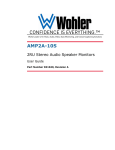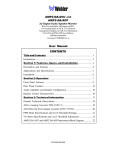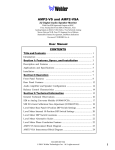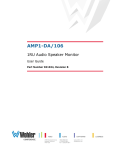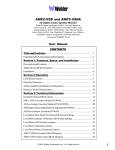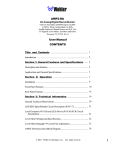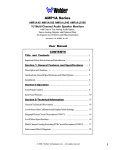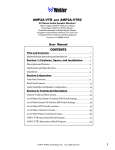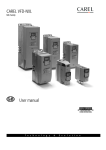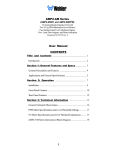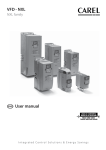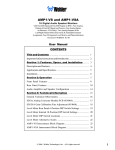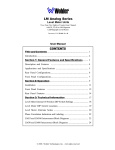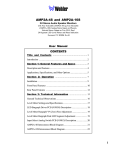Download Wohler AMP1-V2DA User manual
Transcript
AMP1-DA 1U Audio Speaker Monitor with Two Selectable AES/EBU Digital Inputs on BNCs, Two Analog Inputs on XLRs, Stereo Analog Outputs on XLRs, Two 26-Segment Level Meters, and Phase Indication Document P/N 821530 Rev-C User Manual CONTENTS Title and Contents ........................................................................... 1 Important Safety Instructions and Introduction .............................................. 2 Section 1: General Features and Specifications ............. 3 Description, Features, and Applications ................................................... 4 Specifications and Other Options .................................................................. 5 Installation .................................................................................................... 6 Section 2: Operation ...................................................................... 7 Front Panel Features ................................................................................... 8 Rear Panel Features ..................................................................................... 10 Audio Amplifier and Speaker Configuration .................................................. 14 Balance Control Characteristics .................................................................... 14 Section 3: Technical Information .......................................... 15 General Technical Observations .................................................................... 16 AES Input D/A Conveter Module PCB Circuit Description ........................... 17 General Level Meter PCB Descriptions ........................................................ 17 Series II Level Meter Rear Panel DIP Settings .............................................. 18 Series II Level Meter Internal DIP Settings ................................................... 19 Series II Level Meter Internal DIP Locations ................................................ 20 Mute on Error Header H12 Location - 919117 PCB .................................... 21 AMP1-DA Interconnect Block Diagram ....................................................... 22 © 2006 Wohler Technologies Inc. ALL rights reserved 1 Important Safety Instructions 1) Read these instructions. 2) Keep these instructions. 3) Heed all warnings. 4) Follow all instructions. 5) Do not use this apparatus near water. 6) Clean only with dry cloth. 7) Do not block any ventilation openings. Install in accordance with the manufacturer's instructions. 8) Do not install near any heat source such as radiators, heat registers, stoves, or other apparatus (including amplifiers) that produce heat. 9) Do not defeat the safety purpose of the polarized or grounding-type plug. A polarized plug has two blades with one wider than the other. A grounding type plug has two blades and a third grounding prong. The wide blade or the third prong are provided for your safety. If the provided plug does not fit into your outlet, consult an electrician for replacement of the obsolete outlet. 10) Protect the power cord from being walked on or pinched, particularly at plugs convenience receptacles and the point where they exit from the apparatus. 11) Only use attachments/accessories specified by the manufacturer. 12) Use only with the cart stand, tripod, bracket, or table specified by the manufacturer, or sold with the apparatus. When a cart is used, use caution when moving the cart/apparatus combination to avoid injury from tip-over. 13) Unplug this apparatus during lightning storms or when unused for long periods of time. 14) Refer all servicing to qualified service personnel. Servicing is required when the apparatus has been damaged in any way, such as when power-supply cord or plug is damaged, liquid has been spilled or objects have fallen into the apparatus, the apparatus has been exposed to rain or moisture, does not operate normally, or has been dropped. 15) Do not expose this apparatus to rain or moisture. 16) The apparatus shall be connected to a mains socket outlet with a protective earthing connection. CAUTION! In products featuring an audio amplifier and speakers, the surface at the side of the unit, where the audio amplifier heat sink is internally attached, may get very hot after extended operation. When operating the unit excercise caution when touching this surface and ensure that external materials which may be adversely affected by heat are not in contact with it. There is a Hot Surface label (see diagram) attached to the aforementioned surface of the product. Introduction Congratulations on your selection of a Wohler Technologies product. We are confident it represents the best performance and value available, and we guarantee your satisfaction with it. If you have questions or comments you may contact us at: Wohler Technologies, Inc. 31055 Huntwood Avenue Hayward, CA 94544 Phone: (510) 870-0810 Fax: (510) 870-0811 US Toll-Free: 1-888-596-4537 www.wohler.com 2 [email protected] © 2007 Wohler Technologies, Inc. ALL rights reserved AMP1-DA User Manual P/N 821530 Rev-C Section 1 General Features and Specifications Description Features Applications Specifications Other Options 12/01/06 © 2006 Wohler Technologies Inc. ALL rights reserved 3 AMP1-DA User Manual P/N 821530 Rev-C Section 1: General Features and Specifications AMP1-D A AMP1-DA 1U Digital/Analog Audio Stereo Speaker Monitor SOURCE POWER + AES AMP1-DA AVG WOHLER TECHNOLOGIES 1 2 AES1 ANALOG AES2 DIGITAL DIGITAL AUDIO MONITOR PANEL AMP1-DA Front Panel Description The AMP1 Digital series of audio monitors provides self-powered, full-fidelity stereo monitoring in the smallest rack space possible. All models contain four high performance transducers driven by three power amplifiers: two amplifier/driver combinations handle midrange and high frequency information in stereo, while the third center channel reproduces information below the 500 Hz crossover point. All AMP1 Digital models come equipped with a ganged stereo volume control and balance pot, power indication LED, and headphone output. Output limiter circuits are incorporated to protect the speakers, and extensive magnetic shielding allows placement immediately adjacent to video monitors without causing display interference. The AMP1-DA model features two selectable AES input sources on unbalanced BNC connectors and a stereo analog input source on two balanced XLR connectors. A toggle switch on the front panel allows selection of AES source 1 or 2 while another toggle switch selects between the selected AES digital source and the analog source inputs. A red LED indicates the presence and error status of the selected AES signal entering the unit. Two high-resolution 26-segment tri-color LED bargraph level meters display the audio levels for the left and right selected sources and our proprietary three-LED stereo phase indication feature allows monitoring of phase relationships of the selected stereo inputs. An additional pair of XLR connectors are provided on the rear panel for outputing an analog signal of the selected sources for connecting to downstream equipment. Features • 98 dB SPL at two feet • Headphone output • Only one rack space high • Power indication LED • Audible and visual indication of phase/polarity problems • Two 26-segment high-resolution tri-color bargraph level meters • Thorough magnetic shielding for placement next to video monitors • Selectable input Referrence Level (0, +4, +6, or +8 dBu) • Two selectable AES/EBU inputs on unbalanced BNC connectors • Selectable Display Mode (VU Only, VU/PPM, or PPM Only) • Analog stereo inputs on two balanced XLR connectors • Selectable Peak Hold (Manual, 3-Second, 10-Second, or Off) • Analog output of selected input on two balanced XLR connectors • Selectable PPM Ballistics (Type I, Type II, DIN 45406, or SSRT) • AES input signal status indication LED • Selectable alternate Bargraph Scales (AES, Extended VU, Alternative AES, VU, BBC, NORDIC, and DIN) • AES source selection via front panel toggle switch • Digital/analog source selection via front panel toggle switch Applications The AMP1 Digital series is ideally suited for use in VTR bays, mobile production vehicles, teleconferencing installations, multimedia systems, satellite links and cable TV facilities, and on-air radio studios. Designed and manufactured in the U.S., the AMP1-DA is backed by a strong warranty and a satisfaction guaranteed return policy. 4 © 2006 Wohler Technologies Inc. ALL rights reserved AMP1-DA User Manual P/N 821530 Rev-C Section 1: General Features and Specifications General Specifications Digital/Analog Specifications Input connectors: XLR (3-pin female) 2 each BNC (female) 2 each D to A gain calibration, (dB = dBFS): +8 = -20, +4 = -20, +6 = -9, 0 = -18 (DIP selectable) Input impedance: XLR (Analog): 40K Ω balanced BNC (Digital): 75 Ω unbalanced AES sampling rate: 32-48 KHz, auto-select D to A converter: 24-bit low jitter Input Level for Maximum Output (Volume Full On): 0 dBv balanced Input Overload: +26 dBv balanced Peak Acoustic Output (@ 2 ft.): Converted analog out: (S/N): >90 dB Converted analog out: (THD): < 0.008% 98 dB SPL AES Termination: Response, Sixth Octave: Power output Ω): RMS Each Side (4Ω Ω): RMS Bass (4Ω Distortion, Electrical: 80 Hz - 16 kHz ± 7 dB) (-10 dB @ 50 Hz, 22 kHZ) Removable (DIP select) Level Meter Specifications 10 W transient / 5 W continuous 20 W transient / 10 W continuous Less than 0.15% at any level below limit threshold Level Meter Type: 26-segment tri-color LED bargraph Bargraph Quantity: 2 each, vertical LED Color: Tricolor (red, amber, green) Metering Range: 65 dB Distortion, Acoustic: 8% or less at worst case frequencies above 180 Hz including cabinet resonance; typically less than 2% Medium-size Segments Reference Level Select: 0, +4, +6, or +8 dBv (f orNoise: Mid dle -distance ie wing (for Middle dle-distance iewing Hum and Better V than -68 dB below full output Magnetic Shielding: Less than 1 Gauss any adjacent surface Power Consumption (Average Maximum): 35 W AC Mains input: 100-240VAC, 50-60 Hz Display Mode Select: VU Only, VU/PPM, or PPM Only Peak Hold Select: Manual, 3-sec, 10-sec, or OFF PPM Ballistics Select: Type I, Type II, DIN 4506, or SSRT Calibration: Auto Scale Select: AES, Extended VU, Alternate AES, VU, BBC, NORDIC, or DIN Audio Response Physical Specifications Dimension (h x w x d): 1.75 x 19 x 12 inches 44.5x 483 x 298 mm +10 0 d B Weight: 14 lbs. (6.4 kg) -10 -20 -30 20 50 100 200 500 1k 2k 5k 10k 20k Hz Typical 1/6 Octave Audio Response Curve Other Options Wohler Technologies offers the broadest range of standard production audio monitor units. Standard-production models or special order custom features for the AMP1 Digital Series (1U) units include the following functions (and combinations thereof): • SDI (SMPTE259) inputs • Separate channel volume controls • Mono, mute, and mode switches • Alternate level meter scales and color maps • Transformer coupled analog inputs • FULL output power DC operation • External speaker capability • Multiple input and output connector type choices Other custom options are possible. Call your dealer or Wohler Technologies to discuss your specific needs. Units are designed to meet, at time of manufacture, all currently applicable product safety and EMC requirements, such as those of UL and CE. 0 dbV ref. 0.775V RMS. Features and specifications subject to improvement without notice. © 2006 Wohler Technologies Inc. ALL rights reserved 5 AMP1-DA User Manual P/N 821530 Rev-C Section 1: General Features and Specifications Installation Mounting The unit should be mounted where convenient for operating persons, ideally at approximately ear/eye level for best high frequency response and visual observation of the level meters. Its superior magnetic shielding eliminates concerns about locating it adjacent to most types of CRT monitors, including even high-resolution color monitors. NOTE: Be sure to set the level meter Input Level Gain Calibration and VU/PPM Display Mode DIP switch (accessed through the top cover) BEFORE installing the unit into an enclosed rack or console. See page 17 for setting information. Heat Dissipation Heat dissipated by the speaker amps is conducted directly to the left side of the chassis; no special considerations for cooling are necessary as long as the ambient temperature inside the rack area does not exceed approximately 40°C (104°F). Sympathetic Vibration Sympathetic vibration from other equipment (cables, etc.,) in the rack may be serious enough to interfere with the unit’s sound quality out in the listening area. The use of thin card stock and/or felt or foam weather-stripping type materials between adjacent vibrating surfaces, or tying up loose cables, etc., may be required to stop vibrations external to the unit. Mechanical Bracing Even though the unit is fairly heavy, the chassis is securely attached to the front panel at eight points along its surface, not just at the four corners of the chassis ears. This feature will reduce or eliminate rear bracing requirements in many mobile/portable applications. The weight of internal components is distributed fairly evenly around the unit. Audio Connections Connection of the audio feeds is straightforward. Please refer to the system interconnect block diagrams on pages 20 and 21 for clarification of the general signal paths into and out of the AMP2A and AMP2A-2S units. Analog inputs via the 3-pin female XLR connectors are configured for 200K Ω balanced connections. RCA connector inputs (AMP2A only) are configured for 47K Ω unbalanced connections. Electrical Interference Care should be exercised to avoid mismatched cable types and other similar causes of undesired reflections in RF signal systems. If severe enough, such reflections can result in undesirable electrical interference in the audio signals. As with any audio equipment, maximum immunity from electrical interference requires the use of shielded cable; however, satisfactory results can sometimes be obtained without it. The internal circuitry common is connected to the chassis. AC Power The unit's AC mains connection is via a standard IEC inlet, with safety ground connected directly to the unit's chassis. The universal AC input (100-240VAC, 50/60Hz) switching power supply is a self-resetting sealed type, with automatic over-voltage and over-current shutdown. There is no user-replaceable fuse in either the primary or secondary circuit. 6 © 2006 Wohler Technologies Inc. ALL rights reserved AMP1-DA User Manual P/N 821530 Rev-C Section 2 Operation Front Panel Features Rear Panel Features Audio Amplifier and Speaker Configuration Balance Control Characteristics © 2006 Wohler Technologies Inc. ALL rights reserved 7 Section 2: Operation AMP1-DA User Manual P/N 821530 Rev-C Front Panel Features Please refer to Figure-2a on the following page to familiarize yourself with the front panel features of the AMP1-DA unit. The following sections describe these functions and are referenced, by number, to Figure-2a. 1 Speakers The AMP1-DA internal speaker system is comprised of two mid-range tweeter speakers (left and right) and two woofer speakers (left and right). The two mid-range speakers reproduce, in stereo, only the mid and high frequencies, while the two woofer speakers monorally reproduce the low frequencies. See page 14 for more information about the speaker configuration of the AMP1 Series. 2 Volume Control This controls the loudness of the audio reproduced by the internal speakers or connected headphone. Clock-wise rotation of this control increases the loudness of the monitored audio. 3 Headphone Jack Select the headphone audio sources as you would for the internal speakers. When you plug in headphones, the internal speakers will mute. This jack accepts a standard "mini" stereo (ring/tip/sleeve) plug. 4 Power Indication LED This LED glows green to indicate the unit is connected to operational mains power. 5 Phase Indication LEDs These three LEDs offer instant visual verification of phase (polarity) conditions in the pair of channels selected for monitoring in the Left/Right channel speakers. The two smaller LEDs, labeled Φ+ and Φ- (above and below), show instantaneous phase relationships in the signal, while the larger center LED, labeled AVG, indicates the average phase condition. The small top Φ+ LED glows (or blinks) GREEN when signals are in-phase. The small bottom Φ- LED glows (or blinks) AMBER for out-of-phase signals. The larger AVG LED indicates the average phase condition by glowing GREEN for in-phase conditions, or RED for out-of-phase conditions. In general, it is sufficient to regard the AVG LED (average phase condition) as adequate for proper phase monitoring. While it is normal for stereo signals to contain some intermittant instantaneous out-of-phase and in-phase conditions (small LEDs), a steady red glow of the larger LED almost always indicates an out-of-phase alarm condition. 6 Audio Level Meters Audio levels for the selected input sources are displayed via these two 26-segment tri-color (GREEN, AMBER, RED) LED bargraph display level meters. These two bargraph displays feature an Auto-Calibration feature and are user adjustable for Display Mode and Reference Level via a rear panel DIP module (Item F, page 12). Peak Hold, PPM Ballistics, and Alternative Scales can be set via an internal DIP module. See pages 18 and 19 for more information regarding these DIP switch module locations and settings. 7 AES/EBU Signal Status Indication LED This LED indicates the status of the currently selected AES digital signal (AES1 or AES2) regardless of any other monitor selection settings. This LED glows GREEN as long as a valid AES digital datastream is being received. It will glow RED to indicate errors in the reception of the AES signal. There are two DIP switch selectable modes of fault detection that will create a RED LED error indication. Please see Item B, page 10 for more information about this setting. An additional feature of the AES signal error detection is the ability to mute the audio when errors are detected in the AES signal. To enable this feature, a jumper is placed at H12 of the 919117 PCB. See page 21 for location of H12 on the 919117 PCB. 8 Digital Source Select Switch 9 Analog/Digital Source Select Switch 10 This switch selects between the two AES/EBU IN (IN1 or IN2) source inputs (Item C, page 10). Note that for the selected AES source to be monitored, the Analog/Digital Source Select Switch (Item 9) must be set to DIGITAL. When this toggle switch is set to ANALOG, the unit will monitor the analog input signals from the ANALOG IN XLR connectors on the rear panel (Item G, page 14). When this toggle switch is set to DIGITAL, the unit will monitor the selected AES/EBU IN input (IN1 or IN2) on the rear panel (Item C, page 10). Balance Control This pans the volume balance between the left and right speakers. See page 14 for more information about the balance control characteristrics of the AMP1 Series. 11 Bargraph Brightness Adjust This control is recessed into the front panel and can be accessed using a small flathead screwdriver. Turning the trim pot clockwise will simultaneously increase the relative brightness of the LED segments in both bargraphs. 8 © 2006 Wohler Technologies Inc. ALL rights reserved AMP1-DA User Manual P/N 821530 Rev-C Section 2: Operation WOHLER TECHNOLOGIES 1 2 3 POWER 4 5 + AVG SOURCE 1 6 2 11 7 AES 8 AES2 AES1 DIGITAL ANALOG 9 10 1 AMP1-DA DIGITAL AUDIO MONITOR PANEL Figure-2a: Front Panel Features © 2006 Wohler Technologies Inc. ALL rights reserved 9 AMP1-DA User Manual P/N 821530 Rev-C Section 2: Operation Rear Panel Features Please refer to Figure-2b on the following page to familiarize yourself with the rear panel features of the AMP1-DA unit. The following sections describe these features and are referenced, by letter, to Figure-2b. A 1 Power - IEC-320 Connector Attach a standard IEC-320 power cord between this connector and mains power (100 - 250VAC, 50/60 Hz). The front panel Power LED (Item 4, page 8) will glow GREEN to indicate operating voltages are present. B 1 AES/EBU Input Termination and AES Error Fault Type DIP Module AES Input Termination: In the event that either of the AES input channels is connected to downstream equipment, set the appropriate switch to the UP position (UNTERMINATE). If no downstream equipment is connected, then set to the DOWN position (TERMINATE). See below for diagram of termination settings. AES Input 1 Termination ERROR TERM 1 TERM 2 x ERROR TERM 1 TERM 2 x ERROR TERM 1 TERM 2 x Terminated Unterminated 123 4 AES Input 2 Termination 123 4 ERROR TERM 1 TERM 2 x Terminated Unterminated 1234 12 34 Note: Position 3 of DIP switch is not functional AES Error Fault Type: There are two DIP switch selectable modes of fault detection that will create a red error indication in the AES/EBU Signal Status Indication LED; 1) Reception errors: errors in reception of data or no data stream at all (1 = DOWN) or 2) Reception and data errors: errors in reception and data errors identified by the sending device (possibly invalid)(1 = UP). See below for diagram of error settings. AES Error Indication Settings Error/Fault Type = Red LED ERROR TERM 1 TERM 2 x Reception Error (Only) 12 3 4 ERROR TERM 1 TERM 2 x Reception and Data Error 12 3 4 Note: Position 3 of DIP switch is not functional C 1 AES/EBU Input Connectors (IN1 and IN2) These two female BNC input connectors (IN1 and IN2) accept standard AES/EBU signals. These connectors are configured for unbalanced, 75 Ω connections. Only one of the two AES/EBU inputs may be monitored at a time. Selection between AES/EBU inputs IN1 and IN2 is acomplished using the Digital Source Select Switch on the front panel (Item 8, page 8). Note that the unit will monitor the selected AES/EBU channel only when the Analog/Digital Source Select switch on the front panel (Item 9, page 8) is set to DIGITAL. 1 D AES/EBU Input Level Gain Calibration DIP Module Input Level Gain Calibration, the analog level which corresponds to a given digital input value, is settable via this DIP switch. The factory setting is +4 dB (analog) = -20 dBFS (digital). See the silk-screened chart on the rear panel or the diagram below for settings. AES D/A Conversion Gain Calibration Settings 0 dB = -18 dBFS +4 dB = -20 dBFS +6 dB = -9 dBFS +8 dB = -20 dBFS 12 (Continued) 10 © 2006 Wohler Technologies Inc. ALL rights reserved AMP1-DA User Manual P/N 821530 Rev-C Section 2: Operation Figure-2b: Rear Panel Features © 2006 Wohler Technologies Inc. ALL rights reserved 11 AMP1-DA User Manual P/N 821530 Rev-C Section 2: Operation Rear Panel Features (Continued) E 1 Selected Analog Output Connectors (Left and Right) These two 3-pin male XLR connectors (CH.A(L) and CH.B(R)) are analog outputs of the selected digital source as selected for the left and right speakers and level meters. Both connectors are low impedance. The output is not affected by the volume/balance controls or headphone mute. For XLR pinout information see the diagram under Item G. F 1 Level Meter Calibration, Display Mode, and Reference Level DIP Module This DIP switch module sets the Line Level (Auto) Calibration feature, the Display Mode, and the Reference Level for the Audio Level Meters (Item 6, page 8). See page 18 for information on setting these parameters. Note: An internal DIP switch module sets the Peak Hold, PPM Ballistics, and Alternative Scales. See page 19 for information on setting these parameters. G 1 Analog Input Connectors (Right and Left) These two 3-pin female XLR connectors (CH.A(L) and CH.B(R)) accept standard analog audio signals and are configured for balanced, 40k Ω connections. The unit will monitor signals input on these two connectors when the Analog/Digital Source Select switch on the front panel (Item 9, page 8) is set to ANALOG. For XLR pinout information see diagram below. Pin-2 High (+) 12 Pin-1 Gnd (Shield) Pin-1 Gnd (Shield) Pin-2 High (+) Pin-3 Low (-) Pin-3 Low (-) Female XLR Pinout Male XLR Pinout © 2006 Wohler Technologies Inc. ALL rights reserved AMP1-DA User Manual P/N 821530 Rev-C Section 2: Operation Figure-2b: Rear Panel Features © 2006 Wohler Technologies Inc. ALL rights reserved 13 AMP1-DA User Manual P/N 821530 Rev-C Audio Amplifier and Speaker Configuration General Description All AMP1 Series models contain high performance speakers driven by three power amplifiers; two amplifier/driver combinations handle midrange and high frequency information in the left and right (stereo) speaker channels, while the third amplifier channel sums the left and right channel information below the 500 Hz crossover point in the woofer (bass) speaker(s). Note that the woofer channel is NOT a dedicated LFE or Center channel. Speaker Configuration The 1U rack size AMP1 Series products are configured with two speakers (left and right) to reproduce mid- and high-range audio frequencies (in stereo), but feature two woofer speakers to reproduce the summed (combined) low-range audio frequencies from the left and right speaker input channels. It should be noted that both woofer speakers, which are wired in series, are driven from one woofer speaker channel, and are NOT stereo. See the simplified diagram below for a block diagram of the AMP1 Series audio amplifier/speaker configuration. Balance Control Characteristics The balance control attenuates the signal from the source, so that the left and right bass frequencies (summed together and reproduced in the woofer channel) will also respond to the balance control. Example: If an audio signal of a voice speaking English is fed to the "A" (left) input and a voice speaking Spanish is fed to the "B" (right) input, then the left speaker channel will reproduce the mid-range and high-range frequencies of the English speaking voice, the right speaker channel will reproduce the mid-range and high-range frequencies of the Spanish speaking voice, and the woofer speaker channel will reproduce the summed (combined) low-range frequencies of both voices. If the balance control is panned to the left, then the Spanish speaking voice in the right speaker channel will diminish in volume, the Spanish speaking voice in the woofer speaker channel will also diminish, and the English speaking voice in both the right speaker channel and woofer speaker channel will increase slightly (to maintain overall output level). The converse is true if the balance control is panned to the right. See the simplified diagram above for placement of the balance control in the audio amplifier circuit. 14 © 2006 Wohler Technologies Inc. ALL rights reserved AMP1-DA User Manual P/N 821530 Rev-C Section 3 Technical Information General Technical Observations AES/EBU to Analog Converter Module Circuit Description General Level Meter PCB Descriptions Series II Level Meter Rear Panel DIP Settings Series II Level Meter Internal DIP Settings Series II Level Meter DIP Locations AMP1-DA Interconnect Block Diagram NOTE: PCB layout and schematic support documentation is available upon request. Wohler Technologies, Inc. 31055 Huntwood Avenue Hayward, CA 94544 Phone: (510) 870-0810 Fax: (510) 870-0811 US Toll-Free: 1-888-596-4537 www.wohler.com [email protected] © 2006 Wohler Technologies Inc. ALL rights reserved 15 AMP1-DA User Manual P/N 821530 Rev-C Section 3: Technical Information General Technical Observations General Mechanical Observations Elimination of cabinet and component sympathetic vibrations (resonances) requires considerable attention to mechanical details. Because of this, and the physical constraints of the speaker’s acoustic enclosures, even minor changes to any of the mechanical details of the unit can seriously impair its acoustic performance. This especially applies to the speaker baffles. If mechanical work on the unit is necessary, be sure to make adequate notes to permit accurate reassembly. Unfortunately, the unusual and wholly proprietary method of magnetic shielding is usually degraded slightly by any disassembly of the unit, except removal of the rear panel. Almost any maintenance or repair will require removal of the cover. If an immediately adjacent video monitor shows magnetic interference after reassembly of the unit, it must be returned to the factory to restore the shielding completely. General Audio Circuitry Observations Since a single-sided power supply is used, all amplifier sections are “biased” with a 1/2 supply reference, so all opamp signal terminals on the main board should have a DC level of +12V, +/-0.7V. Signal inputs to the main audio board from any of the input select circuits are via the balanced input stage, in lieu of the XLR analog inputs on the basic unit. Signal feed points for level meters and the phase indicator are immediately after the input stage, and before the volume control section. The signal pick-off for the headphones is after the volume and balance controls. Speaker muting is controlled by circuitry that senses connection of headphones to the jack. The power amps are attached to an aluminum heatsink plate (which is also connected to the circuit common for these devices). The heatsink plate forms an operational module separate from the chassis, which allows access to the solder side of the circuit board while power is applied to the circuitry. To avoid thermal shutdown of the power amp(s), they should NOT be operated without their tabs being fastened to the heatsink plate. Variations in the frequency response of different production runs of drivers has sometimes required minor adjustments in the equalization/crossover components in individual runs of units. Some of these components may have values slightly different than those indicated in the schematic, which are the nominal ones. If any of the drivers (speakers) are replaced, it may be helpful to change some of these components to achieve maximum flatness of response. The operating threshold of the woofer limiter is critical to both satisfactory reproduction of musical transients and preventing damage to, or destruction of, the speaker itself. The side speaker output limiter circuits are similarly important, though not as critically adjusted. The woofer power amps are arranged in a bridge configuration; care must be taken to avoid letting EITHER speaker terminal contact the chassis (common) OR THE GROUNDED LEAD OF ANY TEST EQUIPMENT so as not to short out the power amps. The side speaker outputs are single-ended, so these precautions are not necessary for them. 16 © 2006 Wohler Technologies Inc. ALL rights reserved AMP1-DA User Manual P/N 821530 Rev-C AES/EBU to Analog Converter Module PCB Circuit Description There are four primary and three ancillary sections comprising the 919117 AES/EBU digital to analog converter: 1) Input source selection. 2) Audio data extraction. 3) Digital to analog conversion. 4) Analog buffer/output amplifiers. 5) Power suppy, Reset, and Error indication. Input Source Selection (IC13) Each of the two selectable signal inputs are transformer-coupled to the inputs of a one-of-two active buffer/switch (IC13). The output of this switch is applied to the receiver stage of the AES receiver/unframer. Audio Data Extraction (IC11) "Header" and ancillary data are removed from the recovered input datastream, yielding a datastream having only alternating left/right channel audio data which is output on pin 26 of IC11. Digital to Analog Conversion (IC10) The "pure" audio datastream, along with a data clock and a channel ID (left/right) clock, are applied to a 20 bit two channel D to A converter (IC10), where the datastream is converted into left and right analog outputs. Analog buffer (IC4) / Output Amplifiers (IC8, IC9) Buffer/amps provide balanced left and right channel outputs as well as single ended outputs. Gain calibration, the analog level which corresponds to a given digital value, is settable via a DIP switch. The default factory setting is 20 dB below "full code" (digital zero) to equal +4 dbu (0.775V). The other three settings possible are for -18 dBfs = 0 dBu, -9 dBfs = +6 dBu, and -20 dBfs = +8 dBu. See page 18 for DIP switch location and settings. Power Supply The 24V rail internal to the rest of the unit is converted to +5V for digital portions of the 919117 PCB by switching regulator IC12. Error Indication The AES status LED is a bicolor LED (Red/Green). It is green as long as a valid digital data strean is being received. The 8412 receiver is capable of distinguishing two types of error conditions: 1) Faulty data; data identified by the sending device (possibly invalid), or 2) Faulty reception; errors in reception of data or no data stream at all. The red LED indication may be set to occur for only faulty reception (section 1 closed) or with either faulty data OR faulty reception (section 1 open). See Item B, page 10 for more information regarding this setting. An additional feature of the AES signal error detection is the ability to mute the audio when errors are detected in the AES signal. To enable this feature, a jumper is placed at H12 of the 919117 PCB. See page 21 for location of H12 on the 919117 PCB. General Level Meter PCB Descriptions Power Characteristics A +5 voltage (DC) is fed directly to a 4-channel Input Level Meter Engine PCB (919174). Bargraph brightness is regulated from the Bargraph Driver PCB (919173). 4-Channel Input Level Meter Engine Boards (919174) The analog input signals or digital input signals (after conversion from digital to analog) are inputted to the discrete Input Level Meter Engine PCB. This PC boards responsibility is to process tasks such as digital signal processing (DSP), frequency response, integration time, and display mode. The ADSP-2184 chip on each input board handles the entire processing function. A 6-section DIP switch module is located at the rear of these boards, which can be accessed from the rear panel. A combination of DIP switch settings can be use to auto- calibrate the line level input to "0", set the Reference Level, or select the Display Mode. See page 18 for for information regarding these DIP switch settings. A 10-section DIP switch module is located at the front of these boards, which can only be accessed by removing the top cover of the unit (see page 20 for DIP switch locations). A combination of DIP switch settings can be use to select the level meter Peak Hold , select PPM Ballistics, or select any of the Alternative Level Meter Scales. See page 19 for information regarding these DIP switch settings. Bargraph Driver (919173) and Bargraph Display Boards (919172) All the signal information processed from the Input Level Meter Engine PC boards is transfered to the Bargraph Driver PCB (919173) through a 10-pin color coded cable. The Bargraph Driver PCB is in turn connected by a cable to the Bargraph Display PCB (919172), which holds the actual LED Bargraph Module at the front panel. The Bargraph Driver PCBs accept fixed-length word serially, and latch the outputs for the bargraph segments corresponding to those bits in the received word, which are set high. Brightness of the bargraph displays can be adjusted to a desired setting by adjusting the trimpot located on the front panel. All bargraph displays are simultaneously adjusted with this one trimpot. © 2006 Wohler Technologies Inc. ALL rights reserved 17 AMP1-DA User Manual P/N 821530 Rev-C Section 3: Technical Information Series II Level Meter Rear Panel DIP Settings Line Level (Auto) Calibration, Reference Level, and Display Mode This 6-section DIP switch sets the Line Level Calibration, Reference Level, and PPM/VU Display Mode. See below. Line Level (Auto) Calibration: The unit is calibrated at the factory. To recalibrate: 1) Turn on the power. 2) Apply the desired reference level (nominal 0) signal to all channels. 3) Make sure the Reference Level DIP sections (2 and 3) are set to the nearest level of the input signal being applied for calibration (i.e., 0, +4, +6 or +8). The user should make sure that the signal applied to all four channels is within +/- 4 dB of the reference level selected by DIP switch sections 2 and 3. 4) Place DIP section 1 in the DOWN position. 5) Wait 10 seconds. The unit will remove the previous calibration and the new calibration will be applied. 6) Place DIP section 1 in the UP position and return unit to service. 7) Only ONE auto-calibration attempt may be made for each cycling of AC power to the unit. Once the Line Level Calibration DIP switch has been placed in the CAL position, it is necessary to cycle the power before that DIP switch will be functional again, EVEN if a calibration attempt was unsuccessful. If one wishes to calibrate again, turn off the power to the unit and repeat steps 1 through 6. Reference Level: DIP switch sections 2 and 3 determine the Reference Level, which adjusts the level of the input signal and the resultant level displayed on the LED bargraphs. Factory setting is +4 dB. See DIP switch diagram below for settings. Bargraph Display Mode: DIP switch sections 4 and 5 determine how peak levels are displayed for the associated meters on the front panel. There are four possible settings; VU Only, VU-PPM Floating Segment, PPM Only, and PPM-PPM Floating Segment. The VU Only selection has a VU floating segment when a Peak Hold value is selected using the Internal 10-Position DIP Switch Module (see page 19). The factory default setting is VU-PPM Floating Segment. See diagram below for DIP settings. AMP Series Level Meter Rear Panel DIP Switch Settings Meter Calibration 1 Display Mode Reference Level 23 x x Calibrate Operate 123456 45x +8 dB VU Only +6 dB VU-PPM Floating Segment +4 dB PPM Only PPM-PPM Floating Segment 0 dB 123456 123456 Note: Position-6 of DIP switch is NOT used. See the "AMP Series Level Meter Internal 10-Position DIP Switch Settings" diagram on page 19 for separately setting the Peak Hold and PPM Ballistics characteristics. Meter Calibration NOTE: For more accurate indication of signal levels, meters are tuned to effect a “rounding” function, which occurs BETWEEN the thresholds of any two bargraph segments. This means the level meter zero LED segment will turn on at one-half the smallest spacing between LED segments (mid-scale resolution) before that segment's scale indication. Below are the offset amounts for each of the two types of meter. 26-Segment Meters: The "rounding offset" is 0.5 dB for the Analog (extended VU), Digital, Nordic, BBC, and DIN scales. It is 0.25 dB for the VU scale. Example: Using the Analog (extended VU) scale, a meter calibrated for a +4 dBu nominal level will actually turn the zero LED segment of the level meter on at +3.5 dBu (and so all segments will turn on at 0.5 dBu before that segment’s silkscreened scale indication). 18 © 2006 Wohler Technologies Inc. ALL rights reserved AMP1-DA User Manual P/N 821530 Rev-C Series II Level Meter Internal DIP Settings This 10-position DIP switch is accessed by removing the top cover of the AMP unit and is located on the 919174 PCB (the same PCB on which the 6-position rear panel DIP switch is located). See page 20 for a diagram of the 919174 PCB and the DIP switch locations. NOTES: 1) Switch positions 1 and 10 are NOT used and should be left at the factory set position. 2) The Peak Hold - Manual setting allows the bargraph display meters to indefinitely maintain the peak hold value until it is reset by the operator, either by pressing a reset button (a special option specified at time of order) or by removing power and then reapplying power to the unit (unplug/replug power cord). Contact Wohler Technologies for more information about this feature. 3) Contact Wohler Technologies for information about custom scales. PPM Characteristics (Ballistics): The PPM characteristics determine the Integration Time (rise time) and Return Time (fall time) of the level meter. The Integration Time is the time it takes for the lighted segments of the level meter, after application of a 5 Khz tone at a certain reference level, to rise within a specified number of dB of that level. Return Time is the time it takes for the lighted segments of the level meter to fall a certain number of dB after removal of a 5 Khz tone of a certain reference level. The PPM characteristics available for selection using DIP switch sections 7 and 8 of the 10-position Internal DIP Switch (as shown in the above diagram) are as follows: IEC268-10, Type 1: Integration (Rise) Time is 5 ms (-2 dB), Return (Fall) Time is 1.7 seconds (20 dB) IEC268-10, Type 2: Integration (Rise) Time is 10 ms (-2 dB), Return (Fall) Time is 2.8 seconds (24 dB) DIN 4506: Integration (Rise) Time is 5 ms (-2 dB), Return (Fall) Time is 1.5 seconds (20 dB) Single Sample: Integration (Rise) Time is a single sample, Return (Fall) Time is 1.5 seconds (20 dB) © 2006 Wohler Technologies Inc. ALL rights reserved 19 AMP1-DA User Manual P/N 821530 Rev-C Section 3: Technical Information Level Meter DIP Module Locations - 919174 PCB Rear Panel Level Meter 6-Position DIP Switch Module (see page 18) Internal Level Meter 10-Position DIP Switch Module (see page 19) 20 © 2006 Wohler Technologies Inc. ALL rights reserved AMP1-DA User Manual P/N 821530 Rev-C Mute On Error: H12 Header Location - 919117 PCB Note: See page 17 for a circuit description of this PC board. AES to Analog Convertor PCB (919117) Installing aajumper Installing jumperatat H12 will will enable the audio audio H12 mute the to mute when errors in if errors are detected. the AES See pagesignal 14 forare more detected. information. © 2006 Wohler Technologies Inc. ALL rights reserved 21 AMP1-DA Interconnect Block Diagram AMP1-DA User Manual P/N 821530 Rev-C 22 © 2006 Wohler Technologies Inc. ALL rights reserved AMP1-DA User Manual P/N 821530 Rev-C © 2006 Wohler Technologies Inc. ALL rights reserved Section 3: Technical Information 23 AMP1-DA User Manual P/N 821530 Rev-C Wohler Technologies, Inc. 31055 Huntwood Avenue Hayward, CA 94544 Phone: (510) 870-0810 Fax: (510) 870-0811 US Toll-Free: 1-888-596-4537 www.wohler.com [email protected] 24 © 2006 Wohler Technologies Inc. ALL rights reserved
























